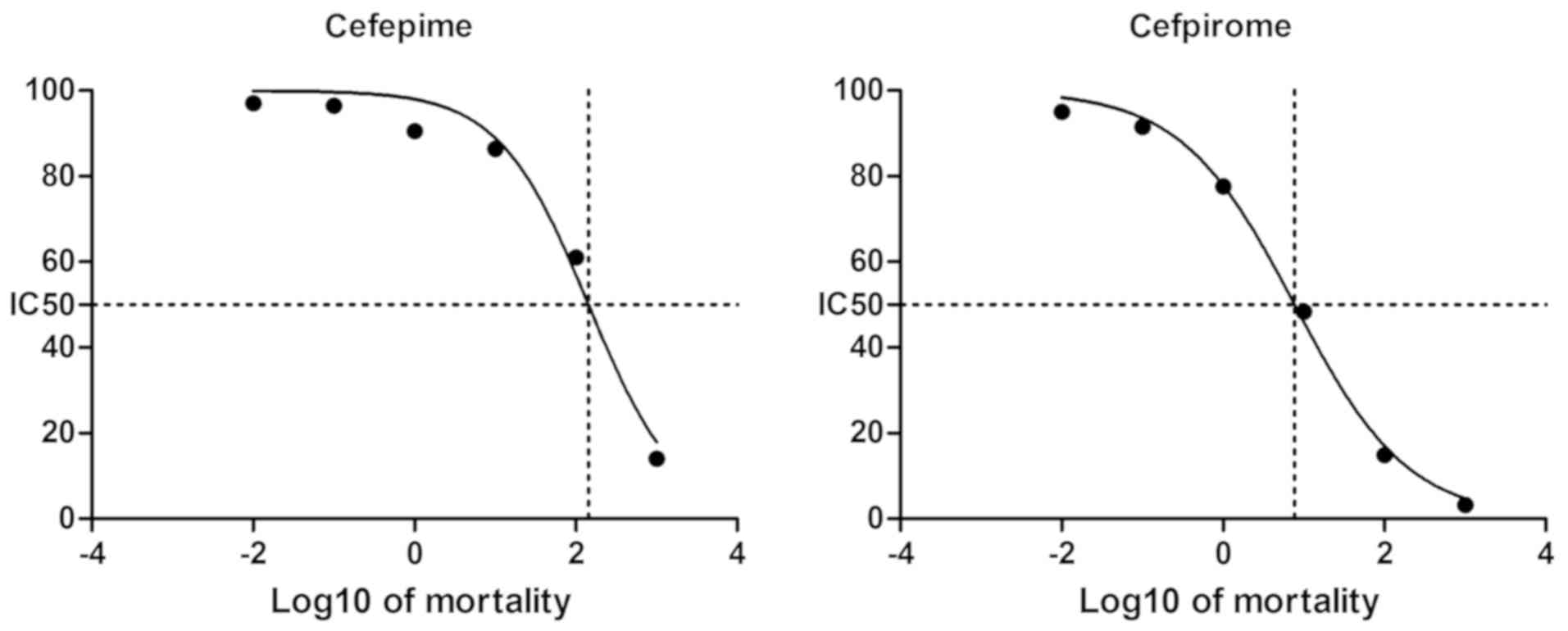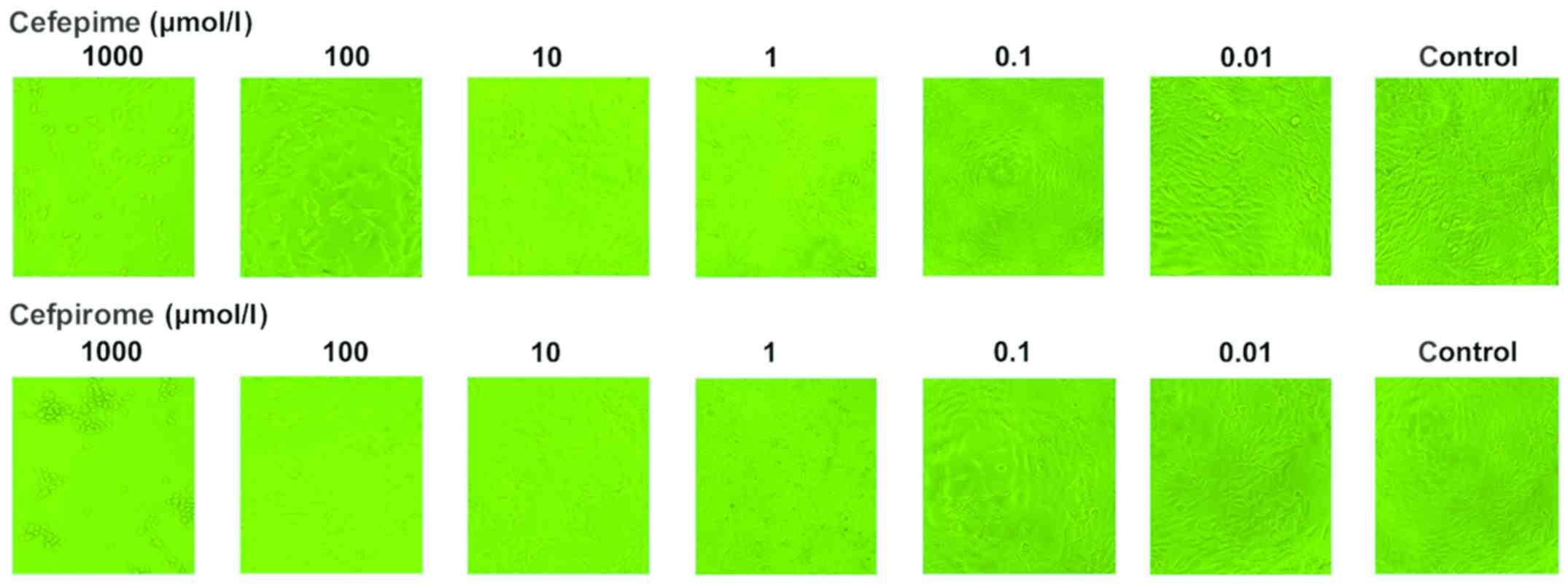Comparison of the influence on renal function between cefepime and cefpirome
- Authors:
- Mingzi Jiang
- Jing Yao
- Li Zhang
- Tianming Gao
- Yang Zhang
- Xiaoqing Weng
- Ganzhu Feng
View Affiliations
Affiliations: Department of Respiratory Medicine, The First People's Hospital of Kunshan City, Affiliated to Jiangsu University, Kunshan, Jiangsu 215300, P.R. China, Department of Respiratory Medicine, The Second Affiliated Hospital of Nanjing Medical University, Nanjing, Jiangsu 210000, P.R. China, Department of Pharmacy, The Second Affiliated Hospital of Nanjing Medical University, Nanjing, Jiangsu 210000, P.R. China
- Published online on: October 6, 2015 https://doi.org/10.3892/br.2015.528
-
Pages:
40-44
Metrics: Total
Views: 0 (Spandidos Publications: | PMC Statistics: )
Metrics: Total PDF Downloads: 0 (Spandidos Publications: | PMC Statistics: )
This article is mentioned in:
Abstract
Although known for their broad spectrum and curative efficacy on drug-resistant pathogens and as nephrotoxicity-free, impairments were observed on renal function during clinical treatment of the two most commonly used fourth-generation cephalosporins: Cefpirome and cefepime. The present study aimed to further explore the exact influences of them on renal function. In vitro, the cell viability of renal cells cultured in drug‑combined medium was tested for six dilutions. In vivo, a clinical cohort study was carried out to detect the influence of cefpirome and cefepime on the serum creatinine (SCr) level of patients. Cefpirome had an inhibition rate with half maximal inhibitory concentration (IC50) of 143.5 µmol/l on renal mesangial cells, which was greater compared to the IC50 of 7.702 µmol/l for cefepime. The clinical cohort study data revealed that cefpirome treatment could lead to a greater increase of the average SCr level compared to cefepime on days 3 and 7 during therapy, and in addition, a greater incidence of SCr >445 µmol/l, an indicator of clinical renal failure. Furthermore, patients with an average age >65 years were observed as more susceptible to an SCr rise caused by either cefpirome or cefepime, with a larger augment in the average SCr, as well as a higher incidence of SCr >445 µmol/l compared to patients aged <65 years. In conclusion, cefpirome may have more potential to cause renal impairment compared to cefepime, therefore, more caution and comprehensive analysis of patient conditions is required during the clinical choice of fourth-generation cephalosporins.
View References
|
1
|
Garau J, Wilson W, Wood M and Carlet J:
Fourth-generation cephalosporins: A review of in vitro activity,
pharmacokinetics, pharmacodynamics and clinical utility. Clin
Microbiol Infect. 3(Suppl 1): s87–s101. 1997. View Article : Google Scholar
|
|
2
|
Gould IM: Do we need fourth-generation
cephalosporins? Clin Microbiol Infect. 5:S1–S5. 1999. View Article : Google Scholar : PubMed/NCBI
|
|
3
|
Saito T, Ichinohe T, Kanda J, et al:
Historical cohort study of the efficacy and safety of
piperacillin/tazobactam versus fourth-generation cephalosporins for
empirical treatment of febrile neutropenia in patients with
hematological malignancies. Int J Clin Med. 2:18–22. 2011.
View Article : Google Scholar
|
|
4
|
Hoffman JM, Frediani J, Herr M, Flynn PM
and Adderson EE: The safety of cefepime and ceftazidime in
pediatric oncology patients. Pediatr Blood Cancer. 60:806–809.
2013. View Article : Google Scholar : PubMed/NCBI
|
|
5
|
Gonçalves-Pereira J and Póvoa P:
Antibiotics in critically ill patients: A systematic review of the
pharmacokinetics of β-lactams. Crit Care. 15:R2062011. View Article : Google Scholar : PubMed/NCBI
|
|
6
|
Deki T, Matsuoka A, Marutani K, et al:
Nephrotoxicity of cefpirome sulfate in rabbits - single and
multiple intravenous administration. J Toxicol Sci. 15(Suppl 3):
173–200. 1990.(In Japanese). View Article : Google Scholar : PubMed/NCBI
|
|
7
|
Cojocel C: Biochemical aspects of the
renal tolerance for cefpirome and other cephalosporins.
Arzneimittelforschung. 40:1140–1144. 1990.PubMed/NCBI
|
|
8
|
Tune BM: Nephrotoxicity of β-lactam
antibiotics: Mechanisms and strategies for prevention. Pediatr
Nephrol. 11:768–772. 1997. View Article : Google Scholar : PubMed/NCBI
|
|
9
|
Rokushima M, Fujisawa K, Furukawa N, et
al: Transcriptomic analysis of nephrotoxicity induced by
cephaloridine, a representative cephalosporin antibiotic. Chem Res
Toxicol. 21:1186–1196. 2008. View Article : Google Scholar : PubMed/NCBI
|
|
10
|
Soni A, Chaudhary M and Dwivedi VK:
Ceftriaxone-vancomycin drug toxicity reduction by VRP 1020 in Mus
musculus mice. Curr Clin Pharmacol. 4:95–101. 2009. View Article : Google Scholar : PubMed/NCBI
|
|
11
|
Yılmaz N, Ilhan S, Nazıroğlu M, Oktar S,
Nacar A, Arıca V and Tutanç M: Ceftriaxone ameliorates cyclosporine
A-induced oxidative nephrotoxicity in rat. Cell Biochem Funct.
29:102–107. 2011. View
Article : Google Scholar : PubMed/NCBI
|











